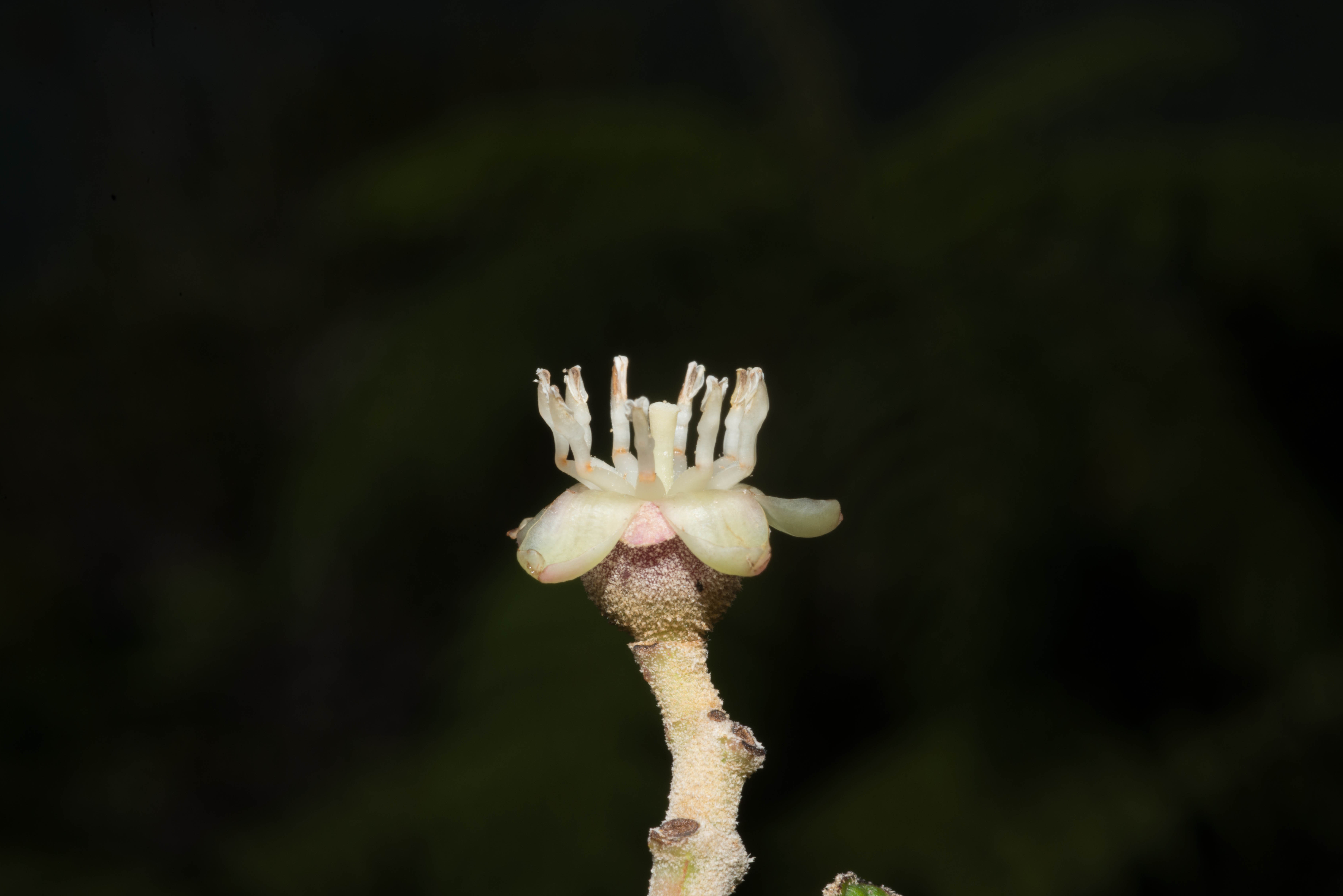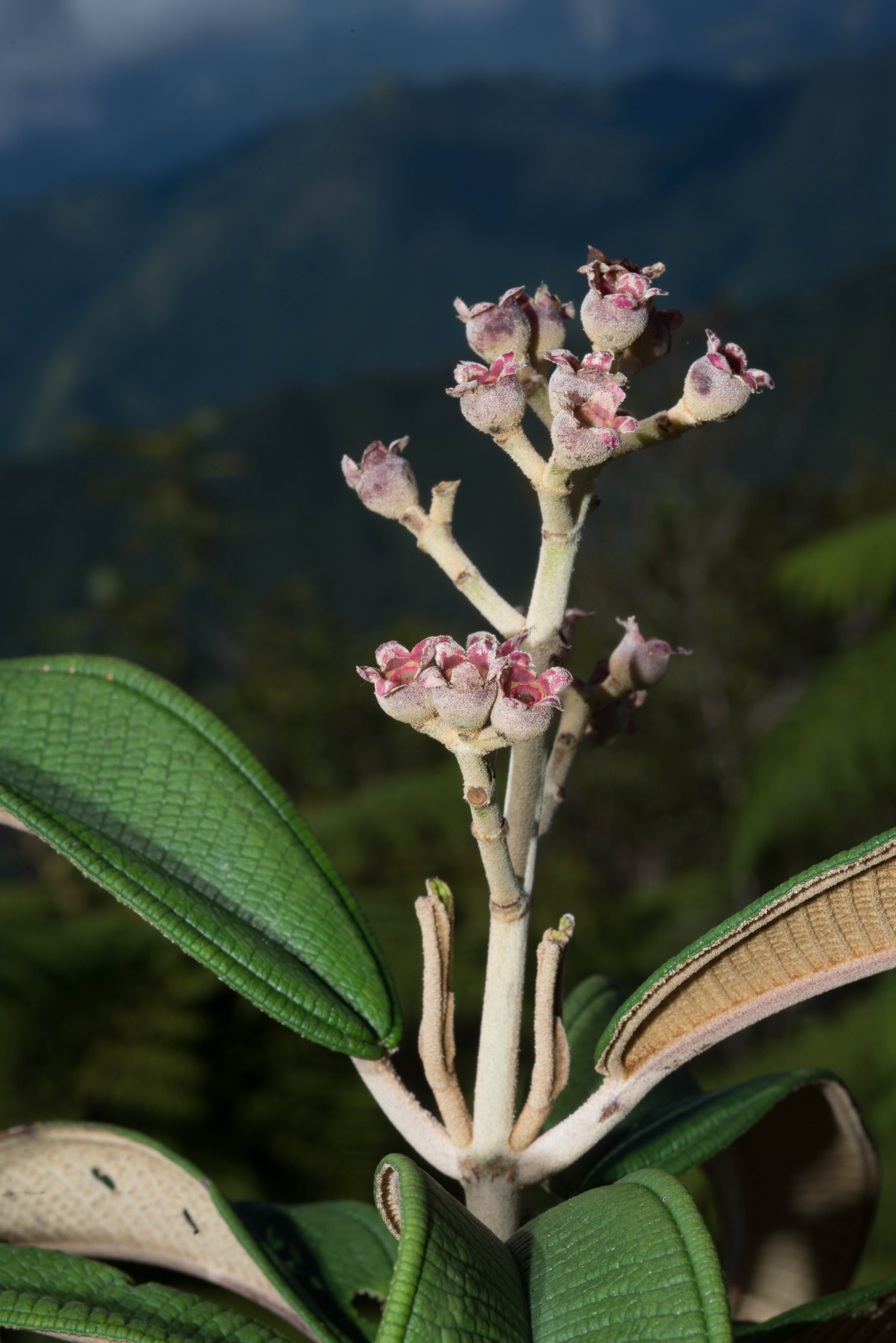Miconia rufa (Griseb.) Triana
Creator(s): F. A. Michelangeli
Description: Miconia rufa: Photo taken in the field , based on Michelangeli 2225.
Rights: Rights reside with creator, otherwise property of NYBG.
-
Family
Melastomataceae (Magnoliophyta)
-
Scientific Name
Miconia rufa (Griseb.) Triana
-
Primary Citation
-
Basionym
-
Description
Description Author and Date: Walter S. Judd, 2010, based on Judd, W. S. (2007). Revision of Miconia sect. Chaenopleura (Melastomataceae) in the Greater Antilles. Systematic Botany Monographs 81:1-235.
Type: CUBA. Guantanamo Prov. [= Oriente p.p.]: Monte Libano, Monte Toro, 1 May [1860-1864, but probably from 1860-61; evidently two different collections are intermixed, one flowering and one fruiting; fruiting material probably from Monte Toro, flowering material probably from Monte Libano], C. Wright 2524 (holotype: GOET!; isotypes: BN!, GH!, GOET!, MO!, NY!, S!, UC!).
Description: Small tree to 9 m tall. Indumentum of multicellular, ferrugineous, irregularly stellate-branched to globular stellate or elongate-branched hairs. Young twigs not ridged, ± elliptic in cross-section, 4-5.5 mm wide, becoming terete with age, the indumentum of dense globular-stellate to elongate-branched hairs; internodes 1.3-4.3 cm long. Leaves with petiole 1.4-3.4 cm long, the indumentum similar to that of the twigs; blade 8.8-19.5 cm long, 1.8-4.4 (-5.8) cm wide, oblong to narrowly ovate or elliptic, flat, coriaceous, the apex acuminate (to acute), the base acute to obtuse, the margin plane, obscurely serrulate, especially distally, ca 5-65% of margin entire, the largest teeth 0.1-0.2 mm long; venation acrodromous, ± basal, with prominent midvein and 4 secondary veins, with 2 conspicuous secondary veins placed 1-3 (rarely to 9) mm in from margin, with 2 inconspicuous secondary veins placed right at margin (or rarely to 2 mm in from margin), and numerous percurrent tertiary veins oriented subperpendicular to midvein, the tertiary veins usually connected by percurrent quaternary veins, higher order veins ± orthogonal-reticulate; adaxial surface green, the indumentum initially of dense stellate to globular-stellate hairs, but very quickly glabrescent, the midvein and major secondary veins impressed to strongly impressed, tertiary veins and minor secondary veins ± impressed to flat, quaternary and higher order veins very slightly impressed to flat, the surface appearing minutely papillose after drying due to dense druse crystals; abaxial surface ferrugineous to pale ferrugineous, with darker hairs on major veins and lighter hairs on lamina, densely covered with irregularly stellate-branched hairs to 0.5-0.9 mm across, intergrading with globular-stellate and elongate-branched hairs to 0.2-0.5 mm across on midvein and major secondary veins, the midvein and major secondary veins prominently raised, tertiary and minor secondary veins raised to slightly raised, quaternary veins very slightly raised, quininary and higher order veins very slightly raised to flat. Inflorescences many-flowered paniculate cymes of 3 to 5 branch pairs, 6.5-12.5 cm long, 4-7.5 cm across; proximal segment of lowermost branches 1.3-2.5 cm long, distal internodes shorter, ultimate branches 3-6.5 mm long, with dense globular-stellate hairs; peduncle 3.3-5.3 cm long, with similar indumentum; each inflorescence branch associated with early caducous bract (not seen); flowers in dichasia, ± distinctly separated from each other, each subtended by 2 caducous bracteoles (not seen). Flowers nearly sessile, the pedicel 0.5-1 mm long. Hypanthium cylindrical, free portion 1.7-2.1 mm long, the outer surface with dense globular stellate hairs, the inner surface glabrous and obscurely to clearly ridged, with 10 ridges, these sometimes alternating with 10 weaker ridges, the apices of at least some of the ridges projecting, 0.1-0.2 mm. External calyx lobes 5, 0.4-2.2 mm long, 2.4-3.3 mm wide, but often appearing slightly longer due tearing of adjacent sepals, broadly triangular to triangular, with acute to acuminate apex, indumentum of dense ± globular-stellate hairs; internal calyx lobes 5, 2.1-3.8 mm long, 2.4-3.3 mm wide, but often appearing slightly longer due to tearing of adjacent sepals, ovate-triangular to elongate-triangular, green to reddish, with dense globular-stellate hairs on both surfaces, the apex rounded, the margin entire and fringed with branched hairs; calyx tube 0.6-1.7 mm long. Petals 5, 4.7-5.5 mm long, 3.3-4.3 mm wide, broadly ovate to obovate, glabrous, white; margin entire. Stamens 10, geniculate; proximal segment 2.6-3.8 mm long; distal segment 3.3-3.6 mm long, with minute dorsal projection, the anther 2.1-2.7 mm long, with fertile portion of anther sacs 1.4-2 mm long, the connective/distal part of filament extended 1.2-2.2 mm beyond the base of the anther. Ovary (3-) 4-, or 5-locular, 1/2- to 2/3-inferior, 3.3-4.3 mm long, 4.3-5.7 mm in diameter, subglobose to short-ovoid, glabrous and ridged, with fluted apical projection to 0.15-0.3 mm encircling the base of style; style 4-5.5 mm long, glabrous; stigma truncate. Berries 8-10 mm in diameter, globose, blue, with moderate to dense globular-stellate hairs. Seeds angular-obovoid, 0.45-0.8 mm long; testa smooth.
Habitat and Distribution: Cuba, Sierra Maestra, but a couple outlying collections (Monte Toro, Monte Libano) also are known, and limited to the provinces of Santiago de Cuba, Guantanamo, and Granma [= Oriente]; moist montane forests; 1200-1974 m. These forests are described in more detail by Leon (1924), Borhidi and Muñiz (1986), and Borhidi (1991).
Phenology: Flowering period poorly known; specimens in flower collected only in May and July.
Taxonomy and Systematics: Miconia rufa probably is most closely related to M. septentrionalis, M. jimenezii, M. subcompressa, and possibly M. hypiodes, i.e., the dense-stellate clade (see discussion under M. subcompressa). The leaves have a dense covering of ferrugineous, irregular stellate to globular-stellate or elongate-branched hairs over the veins and lamina of the abaxial surface. The hairs are frequently darker on the major veins than on the lamina. Miconia rufa is readily distinguished from M. septentrionalis and M. jimenezii because it has non-ridged twigs (see also key). Miconia rufa can be separated from M. septentrionalis by the presence of elongate-branched hairs on the midvein of the abaxial lamina surface (vs. with only stellate hairs), margins of the lamina usually inconspicuously serrate, i.e., the largest teeth to 0.1-0.2 mm long (vs. usually 0.4-3 mm long), and flowers with the inner hypanthial surface 20-ridged (vs. 10 ridged). Miconia rufa is the only member of the dense-stellate clade occurring in Cuba. Populations of M. rufa from the Gran Piedra Range have broader leaves, with the major secondary veins placed farther from the margin (see description). These are only known from sterile specimens (Lopez Figueiras 873, 2628), and additional collections are necessary in order to confirm their taxonomic placement.
- Sorry, no descriptions available for this record.

























